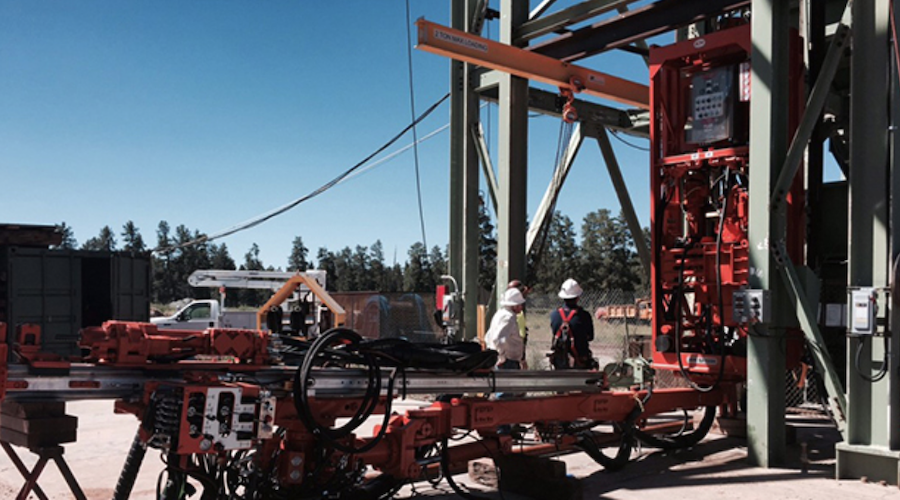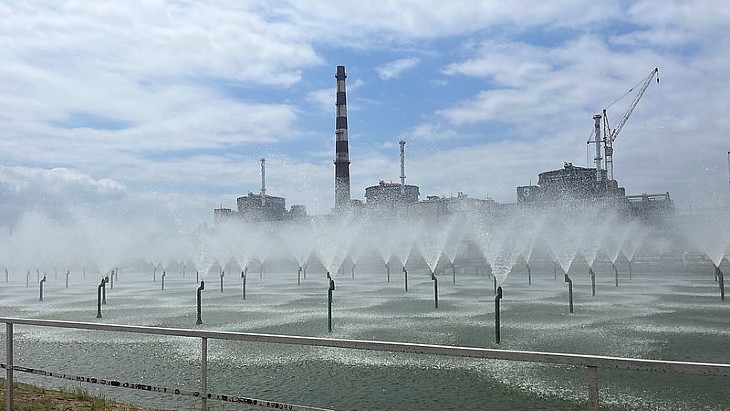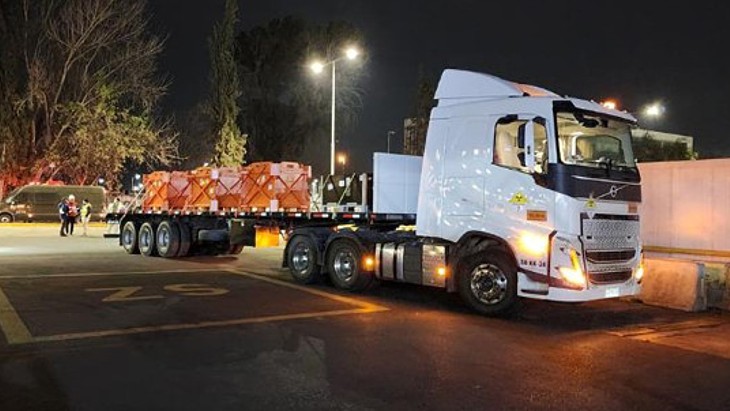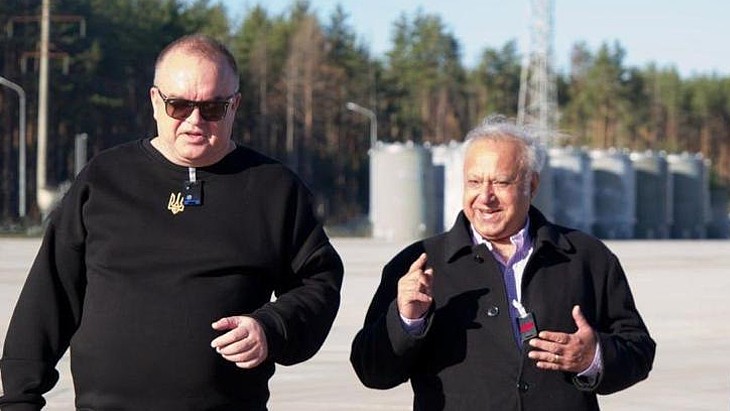Production begins at three US uranium mines
22 December 2023
Energy Fuels has commenced production at three of its permitted and developed uranium mines in Arizona and Utah in response to strong market conditions. The company also expects to begin production at two additional mines in Colorado and Wyoming within a year.
.jpg?ext=.jpg) Energy Fuels' White Mesa mill in Utah is the only currently operating conventional uranium mill in the USA for ore from underground mining operations. (Image: US NRC/Energy Fuels)
Energy Fuels' White Mesa mill in Utah is the only currently operating conventional uranium mill in the USA for ore from underground mining operations. (Image: US NRC/Energy Fuels)Production will be fully ramped up at the Pinyon Plain, La Sal and Pandora mines by mid- to late-2024, by which time Energy Fuels said it expects to be producing uranium at a run-rate of 1.1 to 1.4 million pounds per year, but will be stockpiled at the company's White Mesa mill in Utah for processing in 2025 "subject to market conditions, contract requirements and/or Mill schedule".
Energy Fuels' December 2022 technical report for Pinyon Plain, in Arizona, estimates total proven and probable reserves of 1,567,800 pounds U3O8. Pandora and La Sal are both part of the La Sal Project complex of uranium/vanadium mines in eastern Utah, which has estimated uranium resources of 4.3 million pounds U3O8, all in the inferred category. Reserves have not been reported for La Sal (mineral reserves are the economically mineable part of mineral resource).
The company said it is also preparing the Whirlwind (Colorado) and Nichols Ranch (Utah) mines to commence uranium production within one year, which it says would increase its uranium production to over 2 million pounds of U3O8 per year starting in 2025, "if strong market conditions continue as expected". It also plans to advance permitting and development on the Roca Honda (New Mexico), Sheep Mountain (Wyoming) and Bullfrog (Utah) projects, which it says could expand the company's uranium production to up to 5 million pounds U3O8 per year in the coming years. It also expects to produce 1-2 million pounds of vanadium per year.
In the meantime, it will continue to produce uranium from its alternate feed recycling programme - expected to total about 150,000 pounds U3O8 (57.7 tU) in 2024 - while it stockpiles ore from its conventional mines. It also said it expects to commence an ore buying programme from third-party miners in 2024.
The company said its decision to ramp up uranium production was driven by market and policy factors including strengthening spot and long-term uranium prices; increased buying interest from US nuclear utilities; US and global government policies supporting nuclear energy to address global climate change; and reducing US reliance on Russian and Russian-controlled uranium and nuclear fuel.
The company said it expects to sell 200,000 pounds U3O8 into its existing portfolio of long-term contracts during 2024 - this is expected to occur during the first quarter of the year. It also noted that a "utility customer" has the option to purchase an additional 100,000 pounds U3O8 from the company in 2024. Energy Fuels "holds uncommitted inventory and, with the benefit of future production, will continue to evaluate additional spot and/or long-term uranium sales opportunities during 2024 and beyond," it said.
"Due to the substantial increase in uranium prices, US government support for nuclear energy and nuclear fuel, and a global focus on reducing carbon emissions, Energy Fuels is resuming large-scale uranium production," CEO Mark Chalmers said, adding that current uranium spot prices of "near USD90 per pound" are at their highest since 2007. "Energy Fuels has made the required investments over the past several years to prepare for today's uranium markets, and we are uniquely positioned to successfully resume US uranium production in 2024. This is evidenced by our production of roughly two-thirds of all uranium produced in the US over the past five years."
Researched and written by World Nuclear News
Reuters | December 21, 2023 |

Pinyon Plain mine in Arizona. (Image courtesy of Energy Fuels).
US-based Energy Fuels said on Thursday it had started production at three of its permitted and developed uranium mines in Arizona and Utah, encouraged by higher prices of the heavy metal.

Shares of the company rose 2% to $7.10 in premarket trading.
The company is also preparing two more mines in Colorado and Wyoming for expected production within a year and advancing permitting on several other large-scale US mine projects to increase uranium production in the coming years.
“Due to the substantial increase in uranium prices, US government support for nuclear energy and nuclear fuel, and a global focus on reducing carbon-emissions, Energy Fuels is resuming large-scale uranium production,” CEO Mark Chalmers said in a statement.
Uranium spot prices are currently near $90 per pound – the highest level seen since 2007, when it reached $135 per pound, or over $200 per pound on an inflation-adjusted basis, Chalmers added.
Earlier this month, the US House of Representatives passed a ban on imports of Russian uranium as lawmakers seek to add pressure on Moscow for its war on Ukraine, although the measure has waivers in case of supply concerns for domestic reactors.
Energy Fuels said it expects to be producing uranium at a run-rate of 1.1 million to 1.4 million pounds per year, once production is fully ramped up at the three mines – Pinyon Plain, La Sal and Pandora – by mid- to late-2024.
(By Roshia Sabu; Editing by Devika Syamnath)
Work begins to dismantle Garigliano reactor vessel
22 December 2023
Societa Gestione Impianti Nucleari SpA (Sogin) has begun the process of dismantling the pressure vessel of the boiling water reactor, which the company says is the most complex dismantling activity in the decommissioning of the boiling water reactor plant.
.jpg?ext=.jpg) Removing the vessel head marks the start of the final phase of decommissioning of the boiling water reactor (Image: Sogin)
Removing the vessel head marks the start of the final phase of decommissioning of the boiling water reactor (Image: Sogin)Working with its subsidiary Nucleco, Sogin said it has now removed the top part of the vessel as it enters the final phase of the nuclear decommissioning of the Campania site.
Removing the vessel head means that the rest of the vessel can now be submerged in the reactor channel. This will provide a natural radiation shield for subsequent dismantling operations which will be carried out under water, Sogin said.
Preparatory activities carried out before the removal of the vessel head included restoring auxiliary electrical, ventilation and control systems to the reactor building, as well as the circuit to flood the reactor channel. The removal of the vessel head was carried out under the supervision of Italy's National Inspectorate for Nuclear Safety and Radiation Protection.
Work to remove equipment from the upper part of the reactor vessel is set to be completed in early 2024, after which Sogin said it will start the dismantling work on the vessel and the systems and components of the reactor building.
Garigliano, a 150 MWe boiling water reactor, was connected to the grid in January 1964 and was shut down in 1982. Italy decided to phase out nuclear power in a referendum that followed the 1986 Chernobyl accident and Sogin was established in 1999 to take responsibility for decommissioning the country's former nuclear power sites and locating a national waste store.
IAEA continues to seek reactor rooftop access at Zaporizhzhia
22 December 2023
International Atomic Energy Agency (IAEA) experts were told that security concerns meant they would not be going ahead with their planned access to the reactor rooftops at the Zaporizhzhia nuclear power plant on 19 December.
 This picture was taken during an IAEA visit in June (Image: IAEA)
This picture was taken during an IAEA visit in June (Image: IAEA)
According to the latest update on the situation from IAEA Director General Rafael Mariano Grossi, no alternative date has yet been provided. IAEA teams have previously had access to the roofs of reactors 2, 3 and 4, but not the three other units.
He said that the agency's team at the site, which has been under Russian military control since early March 2022, also had a request to visit the north-western part of unit 5's turbine hall rejected, adding that there has been no access to the north-western part of any of the six turbine halls since mid-October. They are also waiting to be able to see the maintenance plan for 2024.
In the past week the team have visited the reactor hall and electrical safety system rooms of unit 3 and the main control room of unit 5, and visited the site's 750kV electrical switchyard, the on-site water treatment facility, the cooling pond and towers, inlet and outlet channels. They have reported continuing to hear explosions outside of the site, which is on the frontline of Russian and Ukrainian forces.
Belarus 'could be a world leader in nuclear energy share'
21 December 2023
Belarus is considering building a second nuclear power plant, or a third unit at its existing one, and could become one of the leading countries in terms of the proportion of its energy being nuclear-generated, Energy Minister Viktor Karankevich has said.
 (Image: Belta)
(Image: Belta)According to the official Belta news agency, Karankevich noted that, with the commissioning of the second unit at the country's first plant, more than a quarter of Belarus's electricity is now generated by nuclear, and only five countries get more than 40% of their total generation from nuclear.
He said that a decision on more nuclear would depend on evaluation of future electricity consumption: "The construction of the second nuclear power plant or the third unit [of the existing nuclear power plant] is under consideration now ... experts and government agencies are now looking into the matter and are preparing rationalising materials. We are looking into organisational, technical, and economic matters.”
"We intend to reach 44 billion kWh of electricity in 2025. By 2030 we have to reach 47 billion kWh ... as we decide in favour of the second nuclear power plant or the third unit, we have to analyse the year 2040 instead of 2030 or 2035. We have to evaluate how the manufacturing sector will develop, how much electricity Belarusian households will use, how electricity consumption volumes will change."
In a press conference at Belta he said that the energy produced by the two units at the Belarusian Nuclear Power Plant was about 55 million kWh of electricity a day. He also said that tours of the plant were proving increasingly popular, with 3,500 visitors in 2022.
The Belarus nuclear power plant is located in Ostrovets in the Grodno region. A general contract for the construction was signed in 2011, with first concrete in November 2013. Rosatom began construction of unit 2 in May 2014. There are now six VVER-1200 reactors in operation in total, with four in Russia. The first Ostrovets power unit was connected to the grid in November 2020 and, the energy ministry says, the plant will produce about 18.5 TWh of electricity per year, equivalent to 4.5 billion cubic metres of natural gas, with an annual effect on the country's economy of about USD550 million. The second unit was put into commercial operation on 1 November.
The six unit nuclear power plant has one unit - unit 4 - in hot shutdown to produce steam and heat for safety and other functions at the plant and the associated town of Energodar where most of the staff live. The IAEA has in the past urged alternative methods to provide the heat and steam required, so that all six reactors could be in cold shutdown.
In Thursday's update Grossi said that four new mobile diesel boilers were being installed to generate additional steam in addition to nine mobile boilers which are already on site and being used to provide heating.
Grossi said: "Nuclear power plants need significant amounts of steam to conduct important operational activities at the sites. This remains the case also for the Zaporizhzhia nuclear power plant, even though it has not produced electricity for well over a year now. The IAEA has encouraged the plant to install diesel boilers for this purpose and we welcome the planned additional capacity."
For access to external power the site currently relies on the one functioning 750 kV power line and one back-up 330 kV line. There have been eight times during the conflict where the plant has had to reply on emergency diesel boilers after losing access to external power.
The IAEA said that it had also completed the 33rd delivery of nuclear safety and security equipment to Ukraine, using contributions from Australia, and the agency reported that teams at the country's other nuclear energy plants - Rivne, Khmelnitsky, South Ukraine - and the Chernobyl site, said "nuclear safety and security is being maintained despite challenging circumstances".
France and Sweden plan nuclear cooperation
21 December 2023
France and Sweden have signed a declaration of intent to develop long-term cooperation in the field of nuclear energy.
 (Image: @AgnesRunacher on X)
(Image: @AgnesRunacher on X)
The declaration was signed in Brussels on 19 December by Sweden's Deputy Prime Minister and Energy & Industry Minister Ebba Busch (pictured above, left) and France's Energy Minister Agnés Pannier-Runacher (above right).
The declaration calls for the two countries, among other things, to exchange experiences regarding financing models for the expansion of new nuclear power and encourage increased cooperation between the Swedish and French nuclear power industries. In addition, the countries will exchange technical experience in reactor maintenance, as well as lifetime and power upgrades of existing nuclear power reactors.
It says France and Sweden will "promote a regulatory, industrial and financial framework favourable to the realisation of nuclear installation projects with a high level of safety and ensuring institutional support for nuclear energy in compliance with the principle of technological neutrality and with the objective of strengthening Europe's sovereignty and energy security".
In the field of the nuclear fuel cycle, the countries will seek to reinforce the security of supply of nuclear materials and fuels "by endeavouring to promote cooperation between their industries to diversify supply and reduce EU dependence on Russian nuclear materials and services". They will also aim to strengthen bilateral cooperation in the field of used fuel management, radioactive waste management and the associated logistics operations.
The countries noted the close relations that exist between their nuclear regulators, the French Nuclear Safety Authority and the Institute for Radiation Protection and Nuclear Safety and the Swedish Radiation Safety Authority.
"Increased international cooperation on nuclear power is central to enabling a massive expansion of nuclear power in Sweden by 2045," Busch said. "France, like Sweden, has great experience in the nuclear power field and I look forward to strengthening the Swedish-French cooperation."
Last month, the Swedish government unveiled a roadmap which envisages the construction of new nuclear generating capacity equivalent to at least two large-scale reactors by 2035, with up to ten new large-scale reactors coming online by 2045.
IAEA oversees removal of disused sealed radioactive sources from Chile
21 December 2023
A record number of 31 disused sealed radioactive sources (DSRSs) have been transferred from Chile to a recycling facility in Europe as part of an International Atomic Energy Agency multi-regional project to enhance nuclear security and radiation safety.
 Secure transportation was a key part of the process (Image: (Photo: Chilean Nuclear Energy Commission)
Secure transportation was a key part of the process (Image: (Photo: Chilean Nuclear Energy Commission)
Most radioactive waste arising from nuclear applications consists of DSRS. Radioactive sources are used in different devices in medical, industrial and agricultural facilities. They have to be accounted for and when they are no longer usable, they have to be recovered, dismantled, stored and, in some cases, prepared for transportation. The removed DSRSs - mostly cobalt sources used for cancer treatment in Chile - have been in temporary storage since the end of their use in 1992.
The IAEA said that the DSRSs "represent about half of the radioactive material received yearly in waste management facilities from different activities around the country".
Luis Huerta Torchio, director of the Chilean Nuclear Energy Commission (CCHEN), said: "The removal of these sources has multiple benefits for the CCHEN and the whole country, and it is in line with the circular economy objectives, in terms of recycling and reuse. The removal has significantly reduced the risk for any type of incident associated with these disused sources. In addition, it freed up to 30 per cent of space in the national storage facility used for disused radioactive sources, and subsequently extended the possibility of its use for about ten more years."
Olena Mykolaichuk, director of the IAEA’s Nuclear Fuel Cycle and Waste Technology division, said: "The IAEA technically oversaw the removal of the sources from Chile to ensure that it was performed safely and securely. An operation of this scale cannot succeed without the dedicated efforts of organisations like CCHEN, skilled contractors, and the regulatory bodies involved - the experience gained is invaluable and represents a model that can be applied for future projects in other countries."
The three-year IAEA Multi-Regional Project on Sustainable Management of Disused Sealed Radioactive Sources, funded by Canada, began in 2019 with 11 Latin American, African and Pacific countries in its first phase. A second phase began in November 2022 with 24 more countries taking part.
Hildegarde Vandenhove, director of the IAEA's Division of Radiation, Transport and Waste Safety, said: "The increase in the number of participating countries indicates the success of the first phase of the project, the global interest in the safe and secure handling of DSRSs and, at the same time, the amount of work that remains to be done in this field."
The operational plan for Chile was agreed in December 2021 and involved the verification of the radioactive sources, appropriate packaging for transport, transportation and shipment to the recycling facility. The first 17 DSRSs were exported in October 2022 and 14 more in July this year.
First FY2024 recipients of GAIN vouchers announced
21 December 2023
The federally funded vouchers aim to accelerate the innovation and application of advanced nuclear technologies by providing companies access to the extensive nuclear research capabilities and expertise of the US Department of Energy's national laboratory complex.
.jpg?ext=.jpg) ARC Clean Technology, developer of this 100 MW sodium-cooled fast reactor, is one of the recipients (Image: X/@GovNuclear)
ARC Clean Technology, developer of this 100 MW sodium-cooled fast reactor, is one of the recipients (Image: X/@GovNuclear)
GAIN - Gateway for Accelerated Innovation in Nuclear - is an initiative launched in 2016 by the Department of Energy (DOE) Office of Nuclear Energy which helps businesses overcome critical technological and commercialisation challenges of nuclear energy technologies through a voucher system, giving stakeholders access to the DOE's R&D facilities and infrastructure to support the cost-effective development of innovative nuclear energy technologies. All awardees are responsible for a minimum 20% cost-share, which could be an in-kind contribution.
The recipients of the first GAIN vouchers for 2024 are:
- Westinghouse Electric Company, to work with Oak Ridge National Laboratory to perform irradiation testing and associated post-irradiation examination on a ceramic matrix composite for potential use in the eVinci microreactor.
- SHINE Technologies, to partner with Argonne National Laboratory and Sandia National Laboratory to assess sensor technologies and their placement in a fuel recycling system to ensure nuclear materials are adequately tracked.
- Aalo Atomics, to collaborate with the Idaho National Laboratory (INL) to evaluate modelling and simulation capabilities for the fuel and core system of the Aalo-1 microreactor which is inspired by INL's planned MARVEL reactor.
- ARC Clean Technology, Inc, to work with Argonne National Laboratory to update its simulation software with additional passive heat removal capabilities to better model its sodium-cooled reactor design.
- Global Nuclear Fuels - Americas, to partner with Argonne National Laboratory to confirm the viability of their electroreduction technology to convert uranium oxide fuel stock into a metal that can be used for advanced reactor fuel.
- Boston Atomics, to collaborate with Oak Ridge National Laboratory on a design review of an in-vessel fuel handling machine for a horizontally oriented integrated reactor and steam generator.
- Energy Northwest, to work with Argonne National Laboratory to use climate forecasting for the next century to inform the design and selection of future nuclear reactor cooling systems and their impacts on electricity cost.
GAIN's announcement contains links to further information on all the proposals that have been selected to receive vouchers.
Four rounds of GAIN Nuclear Energy Vouchers are planned for FY2024.
Ukraine's centralised fuel storage facility fully operational
20 December 2023
Energoatom and Holtec have announced that Ukraine's new Centralised Spent Fuel Storage Facility (CSFSF) is up and running receiving used nuclear fuel from the country's nuclear power plants.
 Kotin and Holtec International vice president for Ukraine Riaz Awan at the CSFSF site, with HI-STORM casks in the background (Image: Energoatom)
Kotin and Holtec International vice president for Ukraine Riaz Awan at the CSFSF site, with HI-STORM casks in the background (Image: Energoatom)Construction and commissioning of the facility continued despite the on-going war with Russia, which included Russian forces controlling the Chernobyl nuclear site for more than a month in February and March 2022.
Energoatom said that the new facility will save USD200 million a year which it previously had to pay for the used fuel to be transported and stored in Russia. It will also avoid the risk of having to interrupt operation of plants because of a lack of capacity to safely store used fuel.
The CSFSF, located in the Chernobyl Exclusion Zone, is a dry storage site for used nuclear fuel assemblies from the country's VVER-1000 and VVER-440 reactors. It is designed to have a total storage capacity of 16,530 used fuel assemblies, including 12,010 VVER-1000 assemblies and 4520 VVER-440 assemblies. Contracts were signed for its construction with USA-based Holtec International in 2005, though construction only began in 2017.
Energoatom President Petro Kotin said, during a visit to the CSFSF: "The safe, reliable and secure operation of the storage facility is critically important for ensuring the uninterrupted supply of electricity to our citizens... [and] also achieves one of the most important goals in strengthening the energy independence of our country. At the same time, cost savings for the removal and dry storage of spent nuclear fuel from domestic nuclear power plants this year alone have already fully covered the costs of the construction."
Holtec President and CEO Kris Singh said: "Approximately two decades ago, Ukraine began its long quest to establish a supremely safe consolidated interim storage facility to take full control of its used nuclear fuel. That journey has finally come to fruition ... the successful transport and storage of spent nuclear fuel by Energoatom from its operating nuclear reactors to the Central Spent Fuel Storage Facility is a fitting symbol of Ukraine’s resolve to achieve complete operational independence in regard to management of its spent fuel discharged by the country’s fleet of reactors and provide a safe and economic solution for long-term management of used nuclear fuel at its domestic centralised storage facility. This facility now has made Ukraine an international leader in consolidated storage of spent nuclear fuel."
He said Holtec's "high-capacity Double Wall Multi-Purpose Canisters and the world’s most thermally efficient transport cask HI-STAR 190 will become Ukraine’s workhorse to transport the country’s used fuel from its nine reactors to the nation’s consolidated interim storage facility". Although the design life of the new facility is 100 years he said he expected it "to be many times longer".
Most of the equipment for the centre was manufactured at Holtec facilities in the USA, although contractors in Estonia, Italy, Germany and the Netherlands were also involved. Energoatom and Holtec have plans to create a joint venture enterprise to develop a manufacturing and technology centre in Ukraine to localise production of equipment for the storage and transportation of used nuclear fuel and also for equipment for Holtec's small modular reactor.
Kotin said: "Ukraine always strives to demonstrate its innovative leadership in the field of clean energy with the help of advanced technologies, to take concrete steps in the direction of energy independence and diversification, to ensure reliable energy supply for its citizens. We must use advanced and absolutely safe nuclear technology, as our nuclear power generates more than 55% of the country's electricity. This joint cooperation with Holtec provides Ukraine with an excellent opportunity to become a leader in the field of global nuclear energy."
Ukraine currently has nine operating reactors at South Ukraine, Khmelnitsky and Rivne nuclear power plants. A further six units at Zaporizhzhia nuclear power plant have been under Russian military control since early March 2022.
Regulator accepts Diablo Canyon licence renewal application
20 December 2023
Pacific Gas & Electric (PG&E) can operate the two-unit Diablo Canyon nuclear power plant in California beyond the expiry of their current licences (2024 and 2025, respectively) following the acceptance of PG&E's licence renewal application by the US Nuclear Regulatory Commission (NRC).
.jpg?ext=.jpg) Diablo Canyon (Image: PG&E)
Diablo Canyon (Image: PG&E)
PG&E filed the application on 7 November, seeking to extend the plant's operating licences by an additional 20 years.
"The NRC staff has determined the application contains sufficient information to formally docket the application and begin its detailed safety and environmental reviews," the NRC said on 19 December. "With the docketing of the application, the reactors' licences will remain in effect under an exemption to agency regulations until the agency's review is complete."
PG&E originally applied to renew the licences in November 2009, but withdrew the application in 2018 after agreeing to close the plant at the end of its current licences. At that time, it was thought that the plant's output would no longer be required as California focused on an energy policy centred on efficiency, renewables and storage. However, in September 2022 - as California's energy grid saw its highest-ever peak demand during a record-breaking heatwave - the state passed a law allowing the units to continue to operate until 2030 to ensure a reliable energy system.
Normally, NRC regulations allow a reactor's operating licence to remain in effect beyond its expiry date provided that the licensee has already applied for a renewal at least five years prior to expiration, which the NRC calls "timely renewal".
PG&E asked the NRC to resume its review of the licence renewal application, but in January the regulator ruled that a new application would need to be submitted. This meant that PG&E could not meet the timely renewal requirement, and therefore it needed to seek the exemption. Such an exemption, allowing the two units to continue operating while the NRC considers PG&E's application to renew the plant's licence, was granted in early March.
Last week, Californian regulators agreed to extending the operations of the Diablo Canyon plant for an additional five years, to 2030. The California Public Utilities Commission's (CPUC's) approval is subject to three conditions: the NRC must continue to authorise the plant to operate; a USD1.4 billion federal loan agreement must not be terminated; and that the CPUC does not make a future determination that extended plant operations "are imprudent or unreasonable".
"PG&E remains committed to complying with energy policies to ensure the state has the option to keep DCPP online past 2025 to ensure electricity reliability as California continues toward its clean energy future," said Maureen Zawalick, DCPP Vice President. "We are grateful for the opportunity to continue providing homes and businesses across California with safe, clean, and affordable power."
Researched and written by World Nuclear News
No comments:
Post a Comment